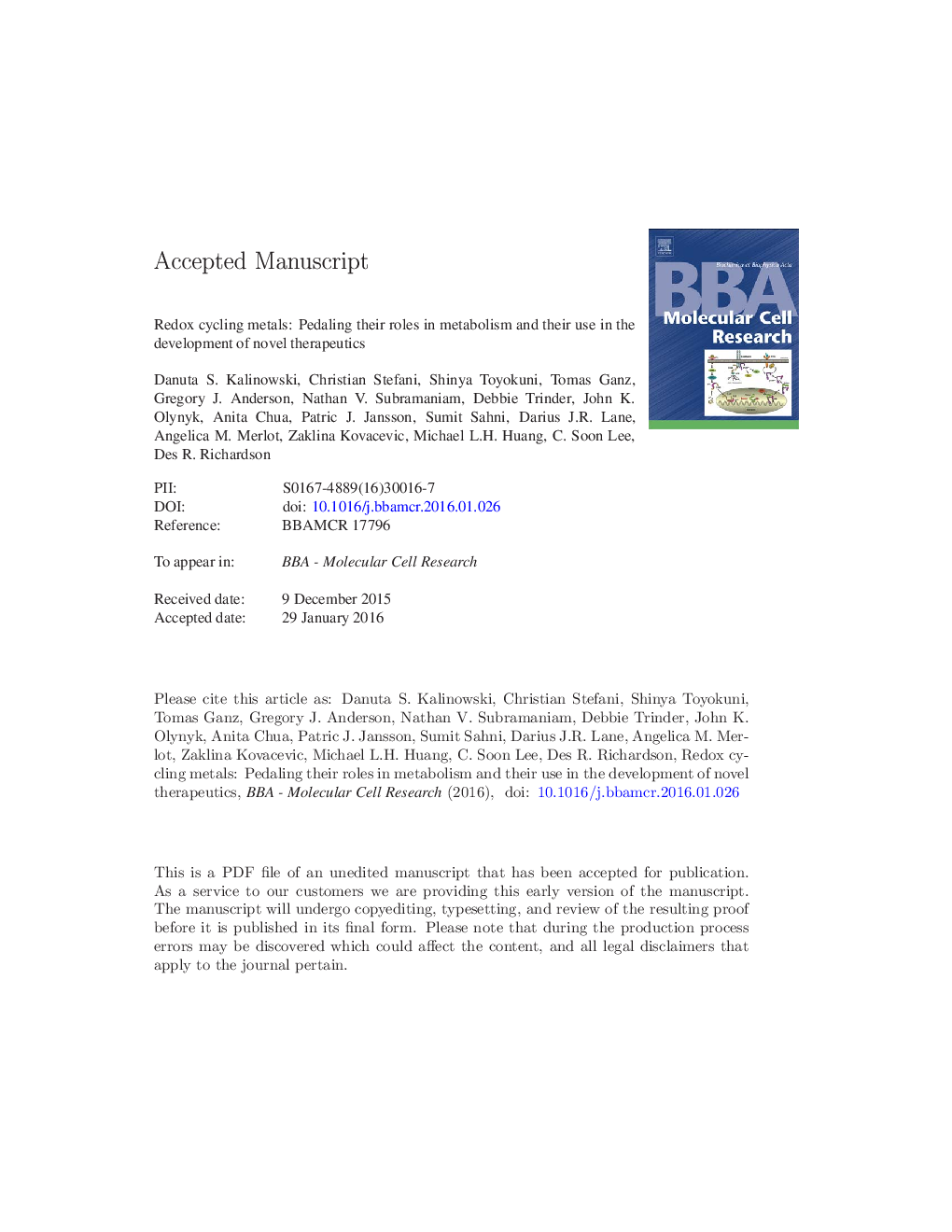| Article ID | Journal | Published Year | Pages | File Type |
|---|---|---|---|---|
| 10801760 | Biochimica et Biophysica Acta (BBA) - Molecular Cell Research | 2016 | 103 Pages |
Abstract
Essential metals, such as iron and copper, play a critical role in a plethora of cellular processes including cell growth and proliferation. However, concomitantly, excess of these metal ions in the body can have deleterious effects due to their ability to generate cytotoxic reactive oxygen species (ROS). Thus, the human body has evolved a very well-orchestrated metabolic system that keeps tight control on the levels of these metal ions. Considering their very high proliferation rate, cancer cells require a high abundance of these metals compared to their normal counterparts. Interestingly, new anti-cancer agents that take advantage of the sensitivity of cancer cells to metal sequestration and their susceptibility to ROS have been developed. These ligands can avidly bind metal ions to form redox active metal complexes, which lead to generation of cytotoxic ROS. Furthermore, these agents also act as potent metastasis suppressors due to their ability to up-regulate the metastasis suppressor gene, N-myc downstream regulated gene 1. This review discusses the importance of iron and copper in the metabolism and progression of cancer, how they can be exploited to target tumors and the clinical translation of novel anti-cancer chemotherapeutics.
Keywords
CREBEGFRNF-κBPI3KFACSDOXTransferrinDFOG6PDbFGFHO-1LIPISCpKaHIF-1αTIBCRGSPGPDMT1Heme oxygenase-1HRECeruloplasminMTDLRP1IRPKTSDPTDPCDesferrioxaminePIHIRETfR1TGNTfR2ZIP14DcytBduodenal cytochrome BFpn1BPTTetrathiomolybdateROCK1Dp44mTNDRG1CTR1lipoprotein receptor-related protein 1regulators of G-protein signaling2-benzoylpyridine thiosemicarbazoneeIF3aNCOA4TRX2CTR2Hcp1PCFTFerroportin 1Fbxl5Bis(thiosemicarbazones)TGF-βO2•-Rho-associated, coiled-coil containing protein kinase 1nuclear receptor coactivator 4UTRα2-M2-OG2-oxoglutarateCDKsFe(II)Fe(III)P-glycoproteinROSTrx1α2-macroglobulinHydrogen peroxideadenylyl cyclaseIronFerric ironferrous ironLabile iron poolepithelial to mesenchymal transitioninterleukinTransforming growth factor βThioredoxin 2tumor necrosis factor alphaEMTThiosemicarbazonesThioredoxin 1Maximum tolerated doseCopper transporter 1iron–sulfur clusterfluorescent activated cell sortingDoxorubicinHydroxyl radicalRibonucleotide reductaseSODCancerSuperoxideSuperoxide dismutaseTrans-Golgi networkhypoxia inducible factor-1αiron responsive elementHypoxia responsive elementVascular endothelial growth factorVascular Endothelial Growth Factor (VEGF)basic fibroblast growth factorTNF-αnuclear factor-κBphosphoinositide 3-kinaseProton-coupled folate transporterDivalent metal transporter 1CopperCu(I)Cu(II)untranslated regionNeuroblastomaH2O2iron regulatory proteincAMP response element-binding proteincAMP-dependent protein kinasePyridoxal isonicotinoyl hydrazonetotal iron-binding capacityAnemia of inflammationcyclin-dependent kinasesglucose-6-phosphate dehydrogenaseReactive oxygen speciesTransferrin receptor 2Epidermal growth factor receptortransferrin receptor 1•OH
Related Topics
Life Sciences
Biochemistry, Genetics and Molecular Biology
Biochemistry
Authors
Danuta S. Kalinowski, Christian Stefani, Shinya Toyokuni, Tomas Ganz, Gregory J. Anderson, Nathan V. Subramaniam, Debbie Trinder, John K. Olynyk, Anita Chua, Patric J. Jansson, Sumit Sahni, Darius J.R. Lane, Angelica M. Merlot, Zaklina Kovacevic,
